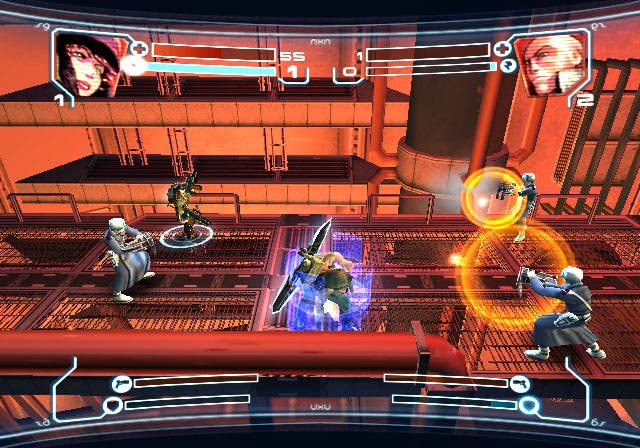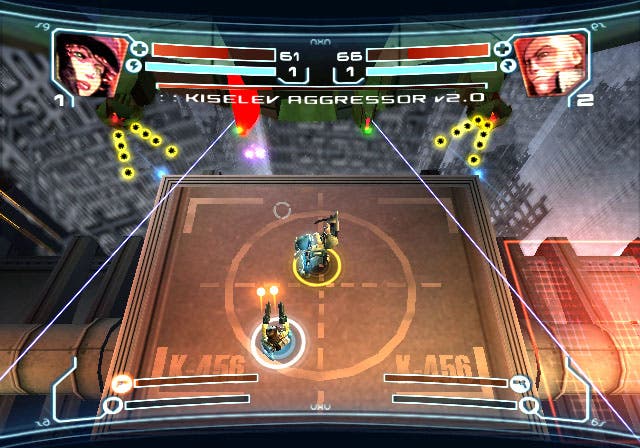The Red Star
Soviet bloc, parry, finishing move.
Alert! Alert! The Red Star's box comes complete with an enthusiastic quote from our very own adorable site. "Ingenious and fresh," we call the game. B...but I haven't even reviewed it yet! What madness is this? Worry not, readers, the publishers have simply performed that age-old underhanded trick of turning conjecture into criticism, and pulled words out of a preview. We're above such tactics, though. The only reason I wanted to bring it to your attention is that these words were written in 2004, nearly three whole years ago. At this point, I think we can discount "fresh."
Given that timespan, it's not hard to surmise that the game's had something of a troubled history. Put on the back burner when original publishers Acclaim went under (probably for another insane publicity stunt in which they tried to create the face of Turok using only the artfully posed bodies of a thousand naked fat men), it languished in limbo, before finally being picked up and released by Take-Two's XS games label in a stripped-down budget form. That spells cynical, get-it-out-for-some-quick-cash reasoning in anyone's book, yet surprisingly, despite spending so long in development, and coming out as scaled-down as it is, it's actually fared pretty well. Despite several flaws, its potential has obviously been realised, and the game's a pretty enjoyable effort as far as I'm concerned.

Exactly how stripped-down is it, though? Well, for those not aware, this is a game based on an Eisner Award-nominated comic (I read that on the back of the box as well. Er, not that that's how I conduct my research of course; there's Wikipedia, too.) in which an alternate Russia has become a competent superpower through the use of might and magic. It layers a colossal, industrial Soviet war machine on top of pseudo mystical sorcery, in a plot of heroes, despots and huge flying mega-ships. Created by Christian Gossett, his art style utilises a blend of traditional pen and ink and computer generated graphics to produce a distinctive visual style.
Now, take a big chunk of that information and throw it out the window. The Red Star game may take influence from its source material, but it's hardly essential: no cut-scenes, no voice-acting, a few lines of briefing accompanying a single static picture of a shouting face, and that's your lot. Readers may recognise a plot line or two as you progresses linearly from one scene to the next in your mission to destroy the evil Troika, but we're not exactly gaining or losing anything by setting it in this universe other than a space to fight.
What it loses in licensing opportunities, though, it makes up for in actual gameplay. This is sheer simplistic chutzpah; brassy and single-minded. If we sheepishly look at the back of the box once more, we can see that we're also quoted as saying The Red Star is "a cross between Streets of Rage and Ikaruga". Well, thanks. That description certainly makes my job easier, but let me elaborate in a bit more detail.
It's Streets of Rage in the way that this is a scrolling beat ‘em up arcade game (but one that's just as dependent on guns). Think also Final, Fight or Golden Axe or Die Hard Arcade or countless others of a genre that once used to walk proudly at the top of our affections. The camera will automatically move between top-down and side-on angles depending on the circumstances as you move along a restricted, linear path. As you progress you're tasked with defeating each sector's enemies before the game removes the invisible barrier it placed and pushing you on to the next part to repeat. Each class of bad guy has his own particular weakness to melee combat or gunplay. Some have shields impervious to bullets, for instance, requiring you to hack and shoot as you must, what strategy there is obviously there simply to thin the crowds in the most efficient way possible. The controls are competent, and the weaponry suitably effective. Meanwhile, the visuals have a bold, chunky feel to them, giving the fighting some weight. And, while its combo system is pretty sparse, and the melee manoeuvres and gunplay never intertwine in the seamless way that Devil May Cry manages, it's a lot of fun.

And Ikaruga? That would be the bullet hell sections. Literally every five minutes there's a boss encounter - usually in the form of a gun emplacement or huge tank - and each is inclined to spit out an insane amounts of deadly glowing bolts as you bob and weave and shoot and shoot. It's a ground-based shmup to all intents and purposes. But instead of the frustrating impossibility of your regular Smash TV assault, it's the patterned chaos of your modern Japanese ship shooter, where considered reflexes can find a path of calm between projectiles no matter how many fill up the screen. Each encounter splits up the fighting perfectly, always a challenge but never long enough to be a chore. Separately, the fighting and the shooting are pretty plain, but together they capably complement any lulls in either. I guess we can grudgingly concede that "ingenious" part of the quote here.
Ironically, for the time when you do actually hop into a ship for some vertically scrolling shooting, it's actually pretty average. Your ship feels rather week and slightly off in its manoeuvrability. Something of a having cake and not being able to eat it scenario.
So what do we have? A low-budget, cheaply presented shooter, which single-mindedly entertains regardless of its simplicity. Well, if you were thinking along the same lines as I was, you'll be hoping this is another Earth Defence Force 2017. By which I mean under-hyped and over the top and a wondrous return to retro blasting in a modern environment. And no, sadly, it isn't 9 material. Not quite.
Why? Because there are one or two niggles that let it down. Chiefly, the insistence to dump you right back at the start of the level if you die. Health packs are only available after boss encounters, so if you get to the end and drown in a sea of bullets, it's a lengthy slog back. You can, however, counter this with the knowledge that enemies always appear in the same place and in the same amount, giving you the opportunity to memorise a clean path through the combat far quicker than your first time. Just like any good shmup, in fact.

Waitasec...that's old school. Yeah!
Then again, the other irritating thing is a ranking system which awards currency for skill. This can then be used to purchase upgrades that improve your weapons and shields, prevent your guns from overheating as much, and so on. Fine, but the prices of each are so high, that if you keep doing badly, you can't actually afford to scrape enough together for improvements. So the worse you do, the harder it effectively gets. How do you solve that one, eh?
But, if you can forgive that slightly unfair system, you'll certainly enjoy yourself. The two playable characters lend themselves to either speed or strength, making each distinctive enough to play through with (plus there's an unlockable bonus character). What's even better is a two player co-op, an essential feature of any game of this type. And while you could argue that it's relatively short, it has variety: new enemies are introduced on almost every level and each boss is distinctive, differing in size, strength or attack pattern to the last.
Perhaps it's because The Red Star is flying so low under the radar, after an inauspicious period in development, that to come out smelling unexpectedly sweeter than it should let's us forgive the majority of its foibles. Without sounding disparaging, it's exactly the game that wouldn't look out of place on Live Arcade where its clear-cut action could gained it more exposure. And let's not forget its budget price, too: at under £20 SRP, it doesn't quite prove its value, but if you can find it for less (e.g. Gameplay is selling it for £12.99), its considered combination of scrolling beat-em up and shmup, justifies the struggle it took to finally get it onto the shelves.
